The word xylophone was coined in 1866 from the Greek roots Xylon, meaning wood, and phone, meaning sound. It is a musical instrument which comprises of a graduated series of wooden bars and it is played by small and spherical wooden hammers. It is the most well-known of all the mallet percussion instruments or the musical instruments played like the drum beating. Xylophones originated from Southeast Asia in the 14th century. They were brought to South America by the African slaves and there developed into the marimba. A xylophone is the precursor of many mallet percussion instruments, including vibes, marimba and xylorimba, which is distinguished by its extended downward range. A xylophone produces short and high pitched sounds while a marimba produces more mellow and sustaining sounds. Whereas the xylophone is played with a hard wood or plastic mallet, marimba and vibes are usually played by softer rubber mallets. Xylophones are usually crafted out of rosewood, which is dark brown, heavy, veined and highly receptive for polish, from the trees of Delbergia Ingra.
1. George Hamilton Green, Jr.
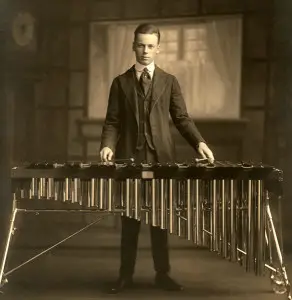
George Hamilton Green, Jr. was born to a musical family in Omaha, Nebraska, U.S. on May 23, 1893. He was a famous xylophonist, composer, illustrator and cartoonist. He was a child prodigy and started playing xylophone the age of four years. At the age of eleven years he was being promoted as the world’s greatest xylophonist. His performance was reviewed in The United States Musician thus: ‘He has begun where every other xylophone player left off. His touch, his attack, his technique, and his powers of interpretation in the rendition of his solos being far different than other performers. To say his work is marvelous and wonderful would not fully express it’. The famous composer, Nathaniel Shilkret, remarked, ‘Green was not only a ‘wonderful xylophone artist,’ but an inventor.’ Shilkret said that Green had designed the vibraphone at Shilkret’s request. Along with his two brothers, he was employed in 1917 by the Edison Company as the sound music crew for Walt Disney’s first three cartoons.
2. Sir Patrick Moore
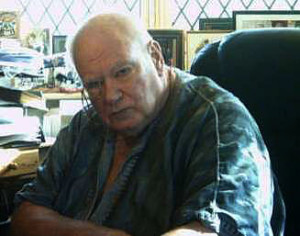
Patrick Alfred Caldwell-Moore was born on March 4, 1923 in Pinner, Middlesex, England and died on December 9, 2012 at the age of 89 years. He was a self-taught xylophonist and an accomplished composer. He was also a pianist and glockenspiel player. A glockenspiel is also a percussion instrument like the xylophone and it is composed of a set of tuned keys arranged like the piano keyboard. Sir Patrick Moore was honored with the title of CBE, Commander of the Order of the British Empire. He was an amateur astronomer and a famous television presenter. In his house located in the seaside Sussex village of Selsy, he had a xylophone in his drawing room, over which hung a notice for visitors ‘No, you may NOT put your cup on the xylophone’.
3. Evelyn Elizabeth Ann Glennie

Evelyn Elizabeth Ann Glennie, DBE, was born on July 19, 1965 in Aberdeenshire. She studied at the Royal Academy of Music and Ellon Academy. She was a member of Cults Percussion Ensemble. She has been profoundly deaf since she was twelve years old. She remarked that she had taught herself to hear with her body parts other than ears. She plays barefooted in studio and live performances. She was inducted into the Percussion Society Hall of Fame in 2008. She has been honored with numerous awards including 15 honorary doctorate degrees, and the U.K. OBE, or Officer of the most excellent Order of the British Empire. In the New Years honors of 2007, she was promoted to DBE, the Dame Commander of the Most Excellent Order of the British Empire.
4. Famoro Dioubate

Famoro Dioubate was born to a musical family in 1965, in Guinea. His grandfather El Hadj Djelli Sory Kouyate is a living legend of the Mandeng Balafon. Balafon is a xylophone of West Africa and the Malinke of Guinea are closely associated with it. The balafon has 18-21 keys, made from rosewood and mounted on a bamboo frame over the dried gourd resonators arranged in graduated sizes. It produces continued nasal sounds. Dioubate learnt about playing xylophone from his grandfather. He also worked with Cheik Smith-Sherif and Sekou Camara Cobra and he co-founded “Les Heritiers” with Sekouba Kandia Kouyate.
5. Leigh Howard Stevens
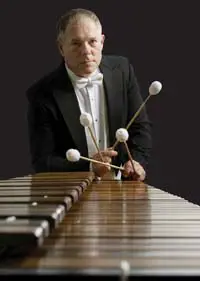
Leigh Howard Stevens was born on March 9, 1953 in Orange, New Jersey. He is an accomplished marimba artist and composer. Marimba is a musical instrument that belongs to the xylophone percussion family. He studied at the Eastman School of music and recalled ‘I noticed when I got to Eastman that the techniques I was using…got a lot of attention. Other people seemed to think that I had a lot of talent on the marimba. I gradually began to realize that I had the potential of being a much better marimba player than I had of becoming a world-class drum set player.” His performance at the first PASIC, Percussive Arts Society International Convention, in 1976, brought him to prominence.
6. Gordon Stout
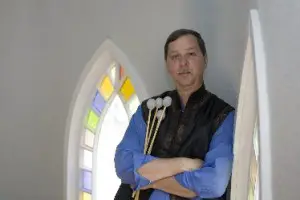
Gordon Stout was born in 1952. He is an American percussionist, composer and educator. Since 1980, he has been a professor of percussion at the School of Music in Ithaca College, in New York. He studied composition with Joseph Schwantner and Samuel Adler. In addition to USA and Canada, he has performed in many other countries, including Europe, Taiwan, Japan and Mexico. He was a featured marimba performer at the World Marimba Festival in Osaka, Japan in 1998. He was on the jury of the first and second Leigh Howard Stevens International Marimba Competitions, held in 1995 and 1998.
7. Ian Finkel
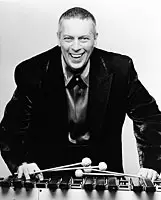
Ian Finkel was born to the Emmy Award winning actor Fyvush Finkel in Brooklyn, New York. Ian Finkel is considered the world’s greatest xylophonist. He has written for and appeared with stars like Michael Feinstein, Ginger Rogers, Sid Caesar, and Madeline Kahn. He has appeared on almost all the famous television stations. Inspired by his father, Ian Finkel said, ‘Everyone in my family is a musician, actor, entertainer, writer, etc… My father is an award-winning actor. Though he didn’t push me in music he gave me a deep devotion to excellence in performance. … Both my brother Elliot”a great pianist”and I follow in our father’s footsteps in his love of art and audience. That’s the way I go’.
8. Teddy Brown
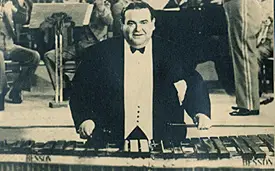
Teddy Brown was born in 1900 and died in 1946. He was an American entertainer. He first played at the New York Philharmonic Orchestra. In 1920s he switched over to popular music. He was an expert percussionist and was an expert player of xylophone, drums and saxophone. As a xylophonist, he came into prominence after his performance in a sound feature-length movie Elstree Calling, directed in 1930 by the then young Alfred Hitchcock. His third appearance in the film was especially impressive and was greatly appreciated by the audience. He played the xylophone with one hand at an amazingly fast precision.
9. Red Norvo
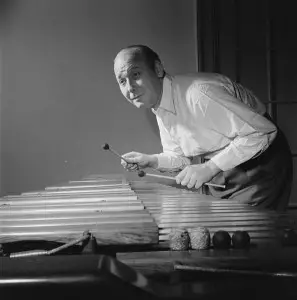
Red Norvo was born on March 31, 1908 in Beardstown, Illinois, U.S. and died on April 6, 1999 in Santa Monica, California., U.S. He played the pivotal role in establishing xylophone, marimba and vibraphone as jazz-compatible instruments. He was the earliest vibraphonist of jazz and was nicknamed Mr. Swing. His recordings include Dance of the Octopus, Hole in the Wall Knockin’ on Wood, Congo Blues and Bughouse. His albums include Live in Australia, On Stage, The Modern, and Red Norvo on Dial. He recorded with his wife Midred Bailey and the couple was known as Mr. and Mrs. Swing. He also recorded with Dinah Shore, Billie Holiday, and Frank Sinatra.
10. Michal Josef Gusikov
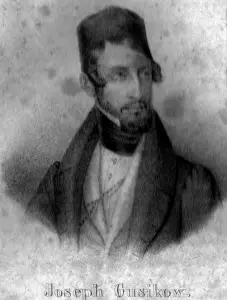
Michal Josef Gusikov was born to the musical family of Klezmer in Shklov, on September 2, 1806 and died in October 1837 at the age of 31 years. In 1831, he devised a new version of the xylophone, which he called a wood and straw instrument. It was basically a xylophone mounted on a soundboard made of straw, which gave it a loud resonance. In 1836, the famous German composer, Felix Mendelssohn wrote, ‘He is quite a phenomenon; a famous fellow, inferior to no virtuoso in the world, both in execution and feeling; he therefore delights me more with his instrument of wood and straw than many with their pianofortes’.
Conclusion
The performance of any instrument, regardless of it being a machine, a gun or a musical instrument, depends much upon the men and women behind them. The performer’s skill really counts. Gifted artists can produce the most melodious sounds from such simple instruments as flutes crafted out of common reeds, while the best of musical instruments fail to impress when in the hands of an amatuer. Of those who are behind the musicals, the composers play the pivotal role. By arranging the basic elements, they can produce an unforgettable piece of music.








Leave a Reply